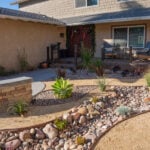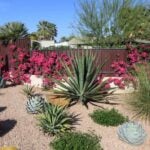Households are increasingly using eco-friendly power sources to improve their landscapes as they strive for a more sustainable and greener future. There are many ways to utilize renewable energy, lessen our influence on the environment, and enhance outdoor areas, from lighting and irrigation to heating and air conditioning. We’ll look at several renewable energy options for landscaping in this in-depth guide, so you may design a beautiful, environmentally responsible green space that is also vibrant.
The integration of sustainable power sources into landscaping has become a desirable and viable option due to technological improvements and increased awareness of environmental problems. Homeowners may greatly lessen their carbon footprint while preserving the beauty and calm of their outdoor settings by utilizing renewable energy sources like solar, wind, and hydroelectric electricity.
Using renewable energy sources in landscaping not only lessens its negative effects on the environment but also enhances the attractiveness and value of outdoor areas. Homeowners may design rich, colorful landscapes that double as refuges for both people and wildlife by adopting sustainable energy sources like solar, wind, and hydroelectric power. There are several methods to make your outdoor haven as environmentally friendly as it is beautiful, whether your goal is to add solar-powered lighting to your garden or install a mesmerizing hydroelectric water feature.
Solar Power:
- The most popular and often used renewable energy source for landscaping is probably solar energy. To harness the sun’s energy and power outdoor lighting, irrigation systems, and other electrical demands, solar panels can be mounted on rooftops, pergolas, or the ground. Furthermore, incorporating solar energy into your landscape design is simple and reasonably priced, and it may improve the aesthetics and usability of your design with solar-powered garden lighting, fountain pumps, and ornamental accents.
Wind Power:
- Another intriguing alternative for powering landscape elements is wind energy, especially in locations with wide terrain or constant winds. Small wind turbines may be placed thoughtfully to provide energy for water features, outdoor lighting, and other facilities. To maximize the strength of the wind and give your outdoor area more visual intrigue and movement. Think about including kinetic art installations or wind sculptures in your landscape design.
Hydro Power:
- Hydroelectric power is a renewable energy source that has no effect on the environment for sites with access to running water. In order to provide energy for outdoor equipment such as irrigation pumps, landscape lighting, and other devices. Micro-hydro systems can be built in streams or creeks. Your outdoor space may be made even more sustainable by using water-efficient landscaping strategies. Like rain gardens, bioswales, and permeable pavement, which can help save water and lessen the need for artificial watering.
Biomass Power:
- For cooking, heating, and outdoor fire features, biomass energy. It is produced from organic resources like wood chips, grass clippings, and agricultural waste—offering an alternative energy source. An eco-friendly and reasonably priced way to extend outdoor living into the cooler months is by using biomass boilers or stoves. Use it to provide heat for fire pits, hot tubs, and outdoor kitchens. Furthermore, nutrient-rich soil amendments for stronger, healthier landscaping can be created on-site through the composting of organic waste products.
Geothermal Power:
- Residential buildings may be efficiently heated and cooled by using geothermal energy. It captures the natural heat trapped under the Earth’s surface. Geothermal heat pumps are a useful tool for landscape designers because they can control the temperature of outdoor living areas, pools, and spas. They do this while using less energy and improving comfort all year round. Homes can benefit from increased energy independence, reduced utility costs, and less environmental impact by utilizing this renewable energy source.
Eco-Conscious Landscaping:
Through the use of sustainable power sources for landscaping. Homeowners may design outdoor areas that are visually stunning while simultaneously improving the health of the environment. There are several ways to power landscape features while lessening their impact on the environment and improving sustainability. It can be done from solar and wind power to hydroelectric, biomass, and geothermal energy.
For landscaping, solar energy is still one of the most affordable and popular renewable energy sources. Homeowners may lessen their dependency on conventional grid electricity and power irrigation systems, water features, and outdoor lighting. You can do this by utilizing the sun’s plentiful energy. Modern solar technology has made it possible to incorporate solar panels into garden paths, pergolas, and trellises. They have done it in a seamless approach that is both aesthetically pleasing and useful.
Another viable option for environmentally friendly landscaping is wind power, especially in places with steady winds or higher altitudes. By carefully positioning wind turbines to power landscape elements you can use wind energy. Like outdoor lights, water pumps, and wind sculptures. In addition to lowering their carbon impact, homeowners may design dynamic and aesthetically pleasing outdoor environments by utilizing wind power.
By adopting these creative fixes, homeowners can turn their outdoor havens into eco-friendly role models for future generations. Every attempt to use renewable energy for landscaping. Whether installing hydropower systems, wind turbines, or solar panels, helps ensure a more sustainable future for our world. By working together, we can design outdoor environments that not only encourage and uplift. Although, also demonstrate our dedication to responsible living and environmental conservation.






